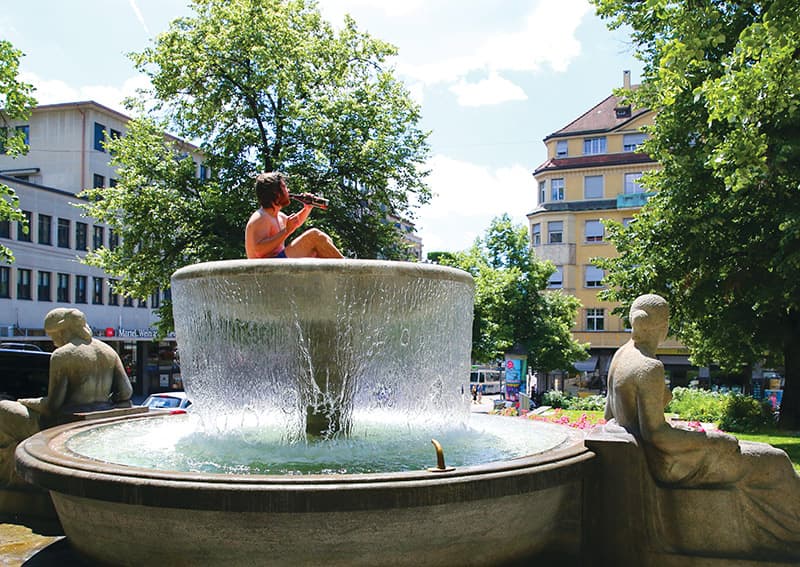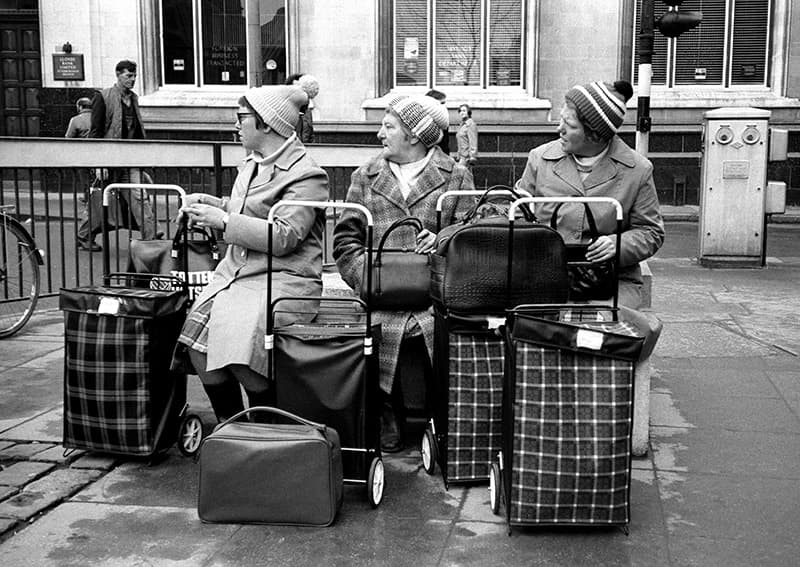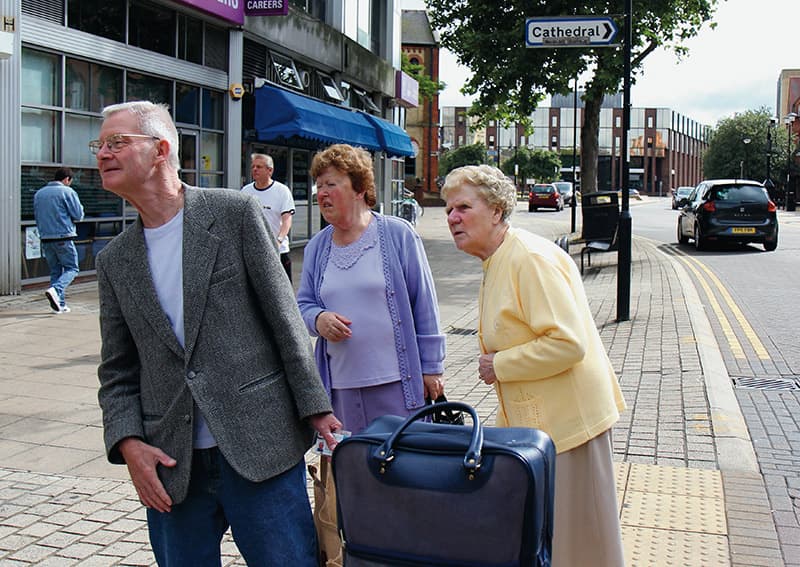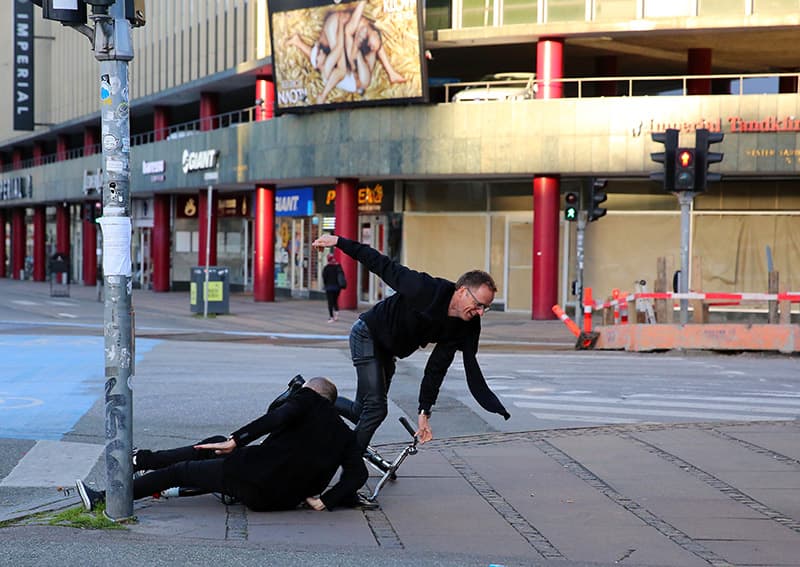
Martha is Portuguese and works in a shop in the Brighton Lanes. This photo makes me smile every time I see it. Her reaction is one of the benefits of engaging with your subjects. Credit: Chris Porsz
Photography has always held a special place in my heart. My mother Krystyna endured the horrors of the Warsaw Ghetto and Ravensbrück concentration camp; her family was murdered and my father, a Polish paratrooper, survived the Battle of Arnhem. Miraculously a few family images survived and that is why photography is so precious, powerful and magical for me. Without it I would have no idea what my family looked like.
I took my first photo using a Kodak Instamatic in 1972 during a trip to North Africa. After seeing the blurred picture of a camel, I upgraded to a Zenit. A Praktica and an Olympus Trip shortly followed this, and then finally a Canon AE-1. When I left school I studied to be a social worker and then dropped out of college to become a casualty porter, which I did for 13 years. In the early ’80s I wandered around Peterborough pointing my camera at society, which satisfied some creative urge and was far easier than writing long sociological essays.

I was lucky to see this man climb into the fountain in Zurich. Credit: Chris Porsz
Self-taught struggles
In the early days when out and about, I always looked for action, protest, the dispossessed and eccentric characters. I excitedly rushed home and marvelled at the ghostly figures appearing but as I was self-taught, many were poor images compounded by my butchery in the darkroom. This only lasted five years, and I got busy raising my three children and began a new career as a paramedic. I fell out of love with photography and hardly picked up a camera for a quarter of a century. Fortunately my long-lost passion was rekindled in 2009, when I sent my old images to my local paper. I was amazed when they gave me a weekly column titled ‘Paramedic Paparazzo.’
I was bitten by the bug again and discovered the joys of the super-efficient digital Canon cameras and felt liberated from the constraints of film. I was like a man on a mission making up for lost time and was now driven by a website rather than an album. My senior rail card and bus pass are a great bonus and the only possible benefit of getting old. My day job and street photography are perfect partners as both involve reassuring complete strangers, gaining trust and reacting instinctively to the unexpected without hesitation. I also find that walking the streets is a good form of exercise.

Taken in 2012 this boy and his friend were running after a ball; luckily I had a fast enough shutter speed. Credit: Chris Porsz
Successes
My column, local exhibitions and first book New England – a collection of images I took back in the 1970s and ’80s – proved popular and kept me motivated. A few characters from this book even started recognising themselves. Despite not having any of my subjects’ contact details, seven years of determined searching and appeals on social media later, I achieved 134 reunions of the same people in the same place three decades on. Rejected by publishers as a bit parochial, I had to self-publish and Reunions was born.
Seeking further inspiration, I visited many European cities, which inspired my book Streets of Europe, and soon after, Streets of Britain was a natural sequel.

Taken as part of my hospital project – the nurses gather around the whiteboard for their handovers. Credit: Chris Porsz
Getting started
Setting yourself a project is a great way to hone your craft and get your work noticed. Ideally choose a subject that is close to your heart such as your job, child’s school, parent’s care home, a club you attend or a sport you play, to fit it in with your weekly schedule. I gained unique access and captured the life of the hospital where I work using my street style of photography. If you cannot get your mojo working or are feeling despondent, struggling to find inspiration, don’t give up. It’s okay to take a break and keep walking, as you never know what is around the next corner. I constantly look for the surreal, humorous interactions that most of us miss as we rush by.
I was inspired by the social documentary and street work of Bert Hardy and Bill Brandt in Picture Post, Harold Evans’ seminal book Pictures on a Page, and the photojournalism of my heroes Robert Capa and Don McCullin. It’s okay to look back at iconic photographers; you can still gain a lot from studying their work without trying to replicate it. For me, it’s Henri Cartier-Bresson’s ‘the decisive moment’ that was paramount to developing my style of street photography.
What next
My role as a paramedic has taught me to live for today and seize the moment, so I am now working on a book about my four decades in our beloved NHS. I would love to do a ‘Reunion’ exhibition and who knows, perhaps a reshoot in 2049 of the images I am taking now. I will only be 96 years old and could always bolt my camera to a Zimmer frame!

Mother and two daughters were waiting for the third daughter to cross the road and join them. Credit: Chris Porsz
To be or not to be
The importance of candidness and engagement in street portraits
One of the main concerns people have with shooting street photography is approaching complete strangers and asking to take their photo and the fear of rejection. But like most things that are out of one’s comfort zone, once you get used to it, it becomes second nature. Occasionally I get a negative reaction and wish I had taken up landscapes, but I find that a smile and an explanation go a long way.
When I engage with my subjects I typically look for eye contact and a reaction, as I often capture more interesting and unexpected responses. While every picture indeed does tell a story, a chat with your subject can often throw up a better one. My best example of this is the subject on the front cover of my Streets of Britain book. ‘Seventy years ago I lit a rocket which went up, across the road, through an open window and burnt a policeman’s house down!’ If I hadn’t taken the time to chat to her, I’d have missed out on a gem of a story like that.
I also love capturing candid shots, when I try to blend in like a lost tourist. However, I totally reject the purist notion that subjects must always be unaware, and my very simple definition of street photography is a picture taken on the streets. Like any genre of photography, there shouldn’t be rules. The interpretation is totally down to the photographer, and both sides of the argument can produce equally great shots.
Chris’s top tips for street photography on the go

Credit: Chris Porsz
Out of the blue
Street photography is all about seizing the moment, so I set my camera to continuous shooting mode and fire off a burst of shots to ensure I don’t miss a thing. I shoot in aperture priority mode with an aperture of f/8 and with the aim of achieving at least 1/800sec by balancing the ISO setting.

Credit: Chris Porsz
Get in close
Robert Capa once said: ‘If your photographs aren’t good enough, you’re not close enough.’ Not only do I want to capture the social context of every situation, I want the viewer to feel part of the scene, so ‘get in close’ is my mantra. The artificial compression of a telephoto is not a natural look, so I never use one.

Credit: Chris Porsz
Primed and ready
Not only do I always carry my camera with me everywhere I go, I have it out of the bag just in case something happens. There’s nothing worse than seeing events unfold in front of you and missing them. If need be, shoot blind on a fast burst from the chest while moving – a scattergun approach but you might get lucky.

Credit: Chris Porsz
All the world’s a stage
The key to street photography is being patient and looking for the optimum moment. Wait for a character who stands out from the crowd to walk on by, and if unsuccessful, find another stage. Experiment with juxtaposition; funny adverts or signs work well, but it’s all about keeping your eyes open.

Credit: Chris Porsz
Let the story unfold
If you spot an interesting subject on your travels, get a few in the can but don’t move on straight away. Stick around and anticipate what could happen next. You never know what other interesting characters may wander into the frame. Add a bonus with a twist by letting serendipity do the rest.
Credit: Chris Porsz
Iconic places
How do you give a unique spin to an iconic location or landmark that has been photographed millions of times before in a different way? Look for a series of events to add interest to the scene that tell a story, or bring buildings or statues alive with characters that give them a sense of scale.
Kit list
- Canon EOS 5D Mark III This is great for low-light work. I did buy a more discreet- looking Fujifilm X100F but it didn’t live up to the quality of my Canon and proved rather fiddly, so it is now my backup.
- Canon EF 24-70mm f/2.8L II USM This lens is permanently attached to my camera with a UV filter for protection. The lens hood comes in handy for both rain and bright sunshine.
- Hard drives I have previously lost precious memories so I have six hard drives, with one being at work in case the house burns down, and I still worry if that is enough.
- Batteries and memory cards I always carry three charged batteries and plenty of memory cards, which I change regularly. For me a double card slot is essential, as I want that extra back up.


 Chris Porsz has three passions in life: street photography, being a full-time paramedic, and his family. In recent years he has published four books and his latest work is currently on show as part of a five-year exhibition at London Luton airport.
Chris Porsz has three passions in life: street photography, being a full-time paramedic, and his family. In recent years he has published four books and his latest work is currently on show as part of a five-year exhibition at London Luton airport.




